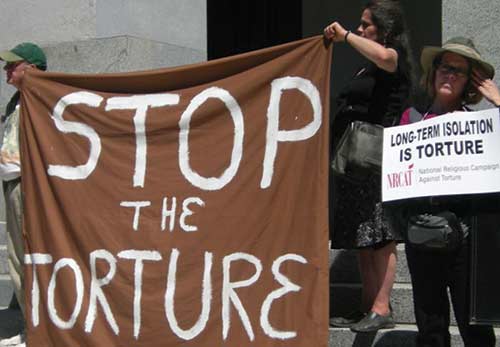
By Toshio Meronek, guest contribution
May 2, 2013
Earlier this month during Oakland’s monthly First Fridays/Art Murmur event, a candlelit vigil was held by a couple dozen protesters – many wearing T-shirts with the message “Stop Torture CA” – to bring attention to California state prison solitary confinement policies which they say amounts to state-sanctioned torture.
According to advocates, as many as 12,000 inmates across the state went on hunger strike in July, 2011 in an effort to bring about changes to long-term solitary confinement policies. It was the largest prisoner hunger strike in U.S. history. The California Department of Corrections and Rehabilitation (CDCR) have not addressed the strikers’ 45 demands, so a group Pelican Bay State Prison inmates announced they and many other prisoners will resume a coordinated hunger strike beginning July 8.
In addition to organizing for improved conditions, the Pelican Bay inmates have successfully reduced inmate-on-inmate violence after calling for an end to hostilities between racial groups.
The State Assembly Committee on Public Safety held hearings in late February on whether the type of solitary confinement the CDCR employs amounts to torture. In March, the United Nations’ torture specialist, Juan Méndez, condemned the use of solitary confinement in North and South America, calling it a “harsh measure which is contrary to rehabilitation, the aim of the penitentiary system.” In 2011, Méndez advised members that solitary confinement for longer than two weeks should be outlawed. But many California prisoners have been subjected to solitary confinement punishments for decades. (Political organizer, Hugo Pinell, for example, has suffered through more than 40 years of it).
All of Us or None, Critical Resistance, Californians United for a Responsible Budget, Legal Services for Prisoners with Children, and Stop Torture CA are among the groups in the Bay Area that have taken a lead on the issue.

Marie Levin
I spoke with Marie Levin, who is a member of the Prisoner Hunger Strike Solidarity group and who organized the Art Murmur vigil. Levin’s also the sister of Sitawa Nantambu Jamaa, a plaintiff in a class-action suit against solitary confinement at Pelican Bay State Prison currently being litigated by the Center for Constitutional Rights and Legal Services for Prisoners with Children.
Are you concerned about your brother’s health, if the prisoners do go on strike?
We’re very concerned about that. It’s really hard on their bodies, and so many of them, when they did it last time, dropped so much weight. My brother lost 19 pounds. It’s something that we as family members don’t want them to have to experience again.
How’d you get involved with the vigils?
The reason why I started the vigil is to get the attention of the public, so they would know what’s happening with the inmates. So many people are unaware of what’s happening with the prisoners. Pelican Bay is isolated. It’s out of sight, out of mind, and so people are not aware.
In February, I went up to visit my brother, and he had talked about doing another hunger strike this year. I knew that they were planning a hunger strike, and a work stoppage. We were sitting around the table, myself, Dolores Canales from LA, Lydia Carbajal, and a young lady named Veronica Martinez. All four of us went up to Pelican Bay together. I said, “We can do this. We can pray for these guys so they won’t have to do the hunger strike, and the work stoppage. We can pray that things can change before they even have to go through that.”
They were just buzzing about how they were going to do this, and I wanted us to have a target. I wanted it to be LA as well as the Bay Area, and for us to all work together. We all decided on a date: the beginning of April, all the way up to June, before the beginning of the proposed hunger strike. What we were targeting was a change of heart from Governor Brown, to end long-term solitary confinement, adequate food for the prisoners, and adequate medical attention. As you know, they have the end to hostilities between different racial groups, and so that was part of what we were targeting in our prayer.
We’re planning in July to do a rolling fast, if they should happen to go through with the hunger strike. We’re looking to get the mock SHU [a.k.a. Security Housing Unit—the CDCR’s fancy name for solitary confinement rooms] down in Sacramento, so the legislators can see it, and perhaps walk inside of it.
Does it make it difficult that most prisons are so isolated, away from major cities?
The hardship is tremendous. I hadn’t been to see my brother in many years. My mother and my older sister, who is now deceased, and one of my aunts would go up to see my brother at least once a year. But the drive, seven to eight hours to get up there, and the cost of having to stay in a hotel, just that alone—the travel, the gas—it’s a big hardship on the families. It’s so far out the way. If you have any kind of medical condition, it would be hard to make it there [at all]. My mother, in particular, can no longer make that trip.
What’s your message to people at the CDCR and the politicians in Sacramento?
What I’d like for them to do is look at what is going on within the CDCR. If they saw the harm that was taking place in these prisoners, then change would come. It’s not just a mental thing; it’s an emotional thing, it’s the lack of being able to touch and feel a human being, the lack of being able to touch and feel their own family members. [I’ve had] to see my brother through a glass wall for 30 years now. All I can do is put my hand on the window.
How can [the prisoners] truly overcome, and feel remorse when they are being attacked? They can’t go through those steps of being remorseful, or feel those feelings of forgiveness from God, for those who believe: “I did this wrong, I committed this crime, and I feel bad for what I did. I need to move on, I need to grow from this point.” They can’t grow because they’re not offered any kind of rehabilitation. There’s no spiritual rehabilitation, there’s no physical rehabilitation, there’s no mental rehabilitation.
Have you, as a family member, found support from other family members of people inside?
The support that I’ve gotten from the women who go up there has been a blessing. I can carpool with them, we share the rooms together, and we share all the costs. We room as if we were family. In the past, we did not have that. It wasn’t until this hunger strike that I even came into contact with any people who were going up there besides my family.
Why do you think this issue should be important to people who don’t have family members or friends in prison?
The amount of money that it takes to house a person in solitary confinement is at least double from the mainline [prison population]. We have a deficit in California. Start there.
Where is the love that Americans have for one another? If you think about the gun laws they were trying to pass, and the Senate did not pass them because of lobbyists. Are you serious? Yet, there are more and more innocent people being hurt and killed because of the lack of love and concern for the people at large. It’s inhumane.
Our government, the governor, and the wardens need to step up and make a difference. Whoever is at the top can make the change. That’s what we want to see.
The First Fridays/Art Murmur vigil will be held every month outside Fox Theater in Oakland at 7 p.m. until July, when the hunger strike is expected to begin. Six concurrent vigils will take place in Bakersfield, Norwalk, Riverside, San Diego, Stockton and Visalia.
Toshio Meronek is a writer focusing on politics, disability, LGBT issues, and prisons. His work has appeared in Dwell, Huffington Post, Hyphen, In These Times, SF Weekly and Truthout.

 The Hunger Site
The Hunger Site
May 12, 2013 at 11:37 am
Long-term isolation isn’t “torture” if the reason you are housed alone is you pose an immanent threat to the livelihood of others, or does it take someone getting killed for people to understand that?